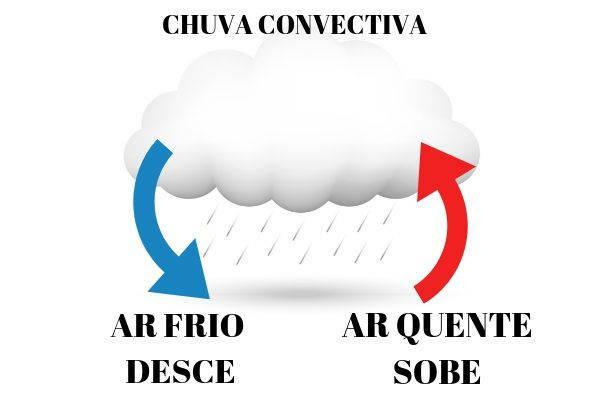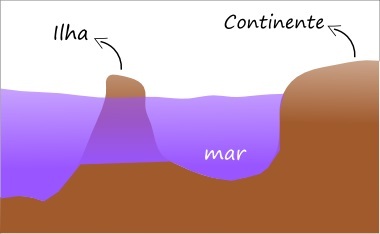types of rain correspond to the different precipitation classifications. This means that rain can have different training processes, as different features, whether in terms of intensity, duration, degree of acidity, and presence or absence of thunderstorms.
Each type of rain is also associated with a specific time of the year or the characteristics of your place of occurrence. Thus, the main types of rain are:
Front rain
convective rain
orographic rain
Read too:Water: an essential resource for life
Do not stop now... There's more after the advertising ;)
what is precipitation
Precipitation is nothing but the back from the water which is in the atmosphere to the earth's surface. The water evaporated from the water resources existing on the surface, then passing from the liquid to the gaseous phase, rises to the atmosphere.
When ascending to the higher layers, this water vapor suffers the condensation process, starting the cloud formation loaded with moisture, which can then precipitate in different ways, such as in the form of rain, hail, snow, fog, among others, thus initiating another
hydrological cycle.→ Factors influencing precipitation
It is known that rains can vary not only according to the time of the year but also about the site features in which they occur.
Understanding these factors also allows us to understand the atmospheric behavior of a given region and, thus, make city planning feasible; predict possible floods; study soil characteristics in order to avoid erosions, by studying the rainfall regime; plan agricultural planting, among others.
In addition, there are other factors that also influence precipitation, according to the Climatology Department of the Federal University of Espírito Santo, such as:
Latitude
distance from the sea
Altitude
Type of vegetation on site
Mind Map: Types of Rain

*To download this mind map in PDF, Click here!
→ Types of precipitation
The return of water to the earth's surface, continuing the hydrological cycle, does not only occur in the form of rain. There are other forms of precipitation, for example:
Snow: precipitation in the form of ice of varying sizes.
Hail: precipitation in the form of ice with a diameter of up to five millimeters.
Dew: precipitation formed due to the condensation of water vapor in the environment at night, given the drop in temperature.
Frost: precipitation formed by water vapor (such as dew) at temperatures below 0 ºC.
Fog: very fine water precipitation with low intensity.
Hail: precipitation that forms ice blocks with a diameter greater than five millimeters.
Lookmore:Difference between snow, frost and hail
types of rain
According to the formation process, the main types of rain are:
→ Front rain

The frontal shower represents the meeting of a cold air mass with a hot air mass.
the frontal rain, also known as cyclonic rain, is the precipitation originating from the meeting between two air masses:one coldand dry and other hotand wet. When the cold air mass advances through a warm air mass, there is what is called a cold front or cold front rain. When the hot air mass advances through a cold air mass, a hot front, or hot front rain, occurs.
The main characteristics of frontal rain are its duration and intensity. Usually, this type of rain is Long term and its intensity may vary.
→ convective rain

Convective rain is characterized by rising hot air and falling cold air.
convective rain, also known as rain of summer, occurs due to surface temperature difference near the layers of the Earth's atmosphere. When an imbalance of the air layers occurs due to some natural phenomenon, the warmer, less dense air rises to the higher layers of the atmosphere, while the cold air descends, as it is denser.
When hot air rises, it carries a lot of moisture with it and is cooled. When it cools, the process of condensation begins, and rain clouds may form. The convective rain is of local scope and characteristic of tropical regions. This type of rain usually has short duration, yet presents greater intensity.
→ orographic rain

The orographic rain is related to the natural barriers imposed by the relief.
orographic rain, also known as relief rain, is the precipitation associated with natural barriers determined by kind of relief Of region. These barriers or obstacles can be, for example, mountain ranges, mountain ranges or mountains. This type of rain is formed when a mass of moist air from the ocean encounters a natural barrier and is forced to rise, reaching high altitudes.
When this mass of moist air rises, it ends up cooling down, suffering condensation and subsequently precipitating. Orographic rain is common in large areas with long lasting and low intensity.
See more:Cyclones: tropical storms that originate in low atmospheric pressure zones
→ Acid rain

Acid rain is the one with a high concentration of acids.
Acid rain is related to your degree of acidity. Every rain has a certain degree of acidity, however, acid rain has it in excess. The pH (hydrogen ionic potential) is the scale that indicates the acidity, neutrality or alkalinity of water. Water in its pure state has pH = 7. The lower the pH, the more acidic the water. To be considered acidic, rain must have a pH below 5.5.
This type of rain has a large concentration of acid oxides, which, when reacting with water particles, form acids that give this rain its main characteristic. Its origin can be:
Natural |
anthropic |
Acid rain is formed through natural processes, such as volcanic activity, which causes the emission of gases, dust and sulfur compounds to the atmosphere, and also by biological processes such as animal and plant respiration. |
Acid rain can be formed based on human action, such as atmospheric pollution caused by the large concentration of vehicles and also by industrial activity. These actions release pollutant gases into the atmosphere, which, when in contact with water, generate acids. |
This type of rain is considered a big problem for the environment and also for the health of living beings. In addition to devastating several areas, acid rain can damage urban monuments and also be associated with some health problems, such as respiratory problems. If you want to go deeper into the topic, read our text: Acid rain.
Curiosities about the types of rain
The orographic rains occur mainly in the Serra do Mar area, which extends for about 1500 km along the Brazilian coast, between the states of Rio de Janeiro and Santa Catarina.
Convective rains are sometimes related to floods in Brazil. Many urban areas are affected by this problem in the period when this type of rain is frequent, given its intensity.
Acid rain occurs mainly in industrialized countries, due to the large concentration of industrial centers in them.
By Rafaela Sousa
Graduated in Geography


